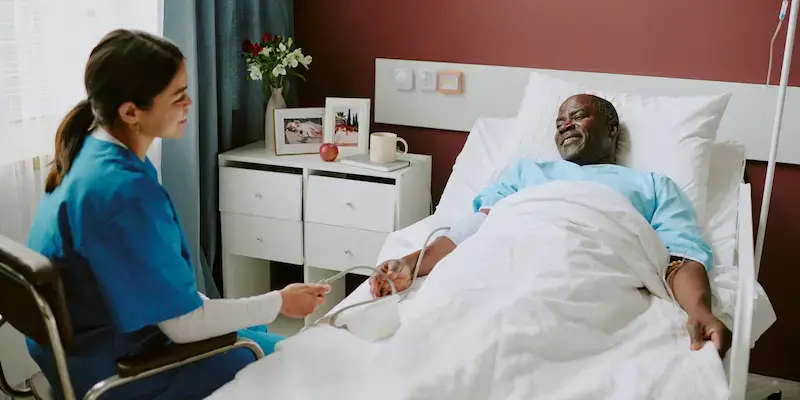Home >
Arthroscopic shoulder decompression and distal clavicle excision
Get rapid access to our leading specialists.
Arthroscopic shoulder surgery is a form of keyhole surgery where a small surgical instrument is inserted into the shoulder to treat certain shoulder conditions. An arthroscopic subacromial decompression is a type of key hole procedure undertaken to treat impingement of the shoulder and relieve pain. Distal clavicle excision is a procedure which involves the removal of the outer end of the clavicle (collarbone) to help with shoulder pain.
Learn more about shoulder decompression and distal clavicle excision at King Edward VII’s Hospital
Why would I need this surgery?
Most people requiring arthroscopic shoulder decompression and distal clavicle excision need it because they have persistent shoulder or upper arm pain, swelling or restriction of movement that hasn’t responded to other treatments.
What symptoms does the surgery address?
Arthroscopic shoulder decompression and distal clavicle excision is often used to help treat shoulder conditions such as shoulder impingement, arthritis of the acromioaclavicular joint (ACJ), or to help damaged, worn or inflamed shoulder tendons.
Arthroscopic shoulder decompression helps to relieve shoulder pain caused when the tendons of the shoulder rub on the bones and ligaments within the shoulder joint. This pain can be felt most when the arm is lifted up, in a condition called rotator cuff impingement syndrome, and manifests as pain around the side of the shoulder and upper arm.
Removing the end of the clavicle through distal clavicle excision relives pressure on the shoulder joint and will help ease the pain and loss of motion caused by ACJ arthritis.
When should you speak to your specialist about surgery?
If you have shoulder or upper arm pain caused by an unknown reason, or by injury, speak to your specialist. They will suggest a series of tests and scans to see what treatment best suits you.
How is the surgery performed?
Arthroscopic shoulder decompression surgery is usually performed under general anaesthetic and may also be performed with a local anaesthetic injected into the nerves in your neck, called an interscalene nerve block.
It’s a keyhole surgery procedure and your surgeon will insert a long, thin surgical device called an arthroscope into your shoulder. They will then create space within your shoulder joint by shaving away any excess bone and releasing any tight ligaments.
Distal clavicle excision is usually done through keyhole surgery. Your surgeon will insert a long, thin surgical device into your shoulder to remove the end of the bone.
What is the recovery like from this surgery?
Your recovery from surgery will depend on multiple factors, including your age, fitness level and the nature of your procedure.
When you wake from surgery, your wounds will be dressed and your arm will be in a sling. Following surgery, you may feel nothing as the local anaesthetic will be keeping the area numb. But as this wears off, you may feel sore and stiff, but you will be provided with pain killers as an in-patient and on discharge to take home with you.
Your nursing and physiotherapy team will give you advice that will help you best recover, based on advice from your surgeon. This includes when you dress yourself and use your arm, when your stitches should be removed or dissolved by and when your dressings should come off.
Most patients are able to go home on the same day as their operation. You will also be advised how long you may need off work and resting from your normal activities. This is usually between 2-4 weeks, depending on your job.
Are there any risks/complications associated with this surgery?
As with any medical procedure, it’s possible for risks or complications to arise. Speaking with your specialist or surgeon beforehand will help you avoid any adverse reactions.
This surgery has a relatively low risk of serious complications, but the following risks and complications can occur in a small number of cases:
- An infection in the surgical wound
- Bleeding inside the shoulder joint
- Frozen shoulder
- A blood clot called a deep vein thrombosis (DVT)
- Nerve damage
- Stiffness
- Swelling
- COVID
How can I prepare for surgery?
Prior to your surgery, your surgeon will discuss with you how best to prepare, as each patient is different with differing needs.
Common preparations include:
- Routine blood tests, x rays or scans as requested by your surgeon
- Taking steps to stop smoking if you smoke
- Losing weight if you’re overweight
- Remaining active and doing regular exercise
Are there alternatives for arthroscopic shoulder decompression surgery?
Depending on the severity of your shoulder discomfort, it may be possible to manage your pain using painkillers, steroid injections and physiotherapy.
Call 020 3627 5160 or fill in your details below to make an enquiry
Need further help or advice?
Contact our team for enquiries or information.
If you need to contact us in any other way, please go to
